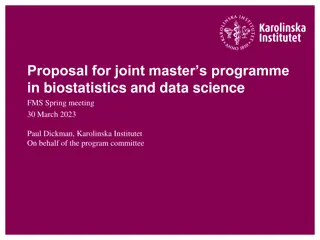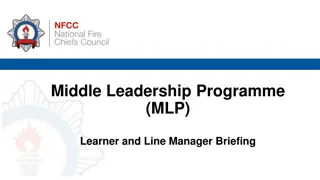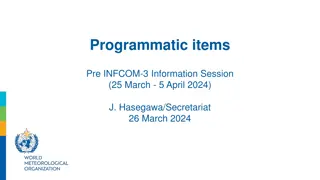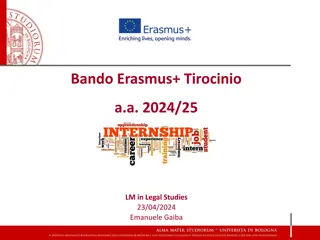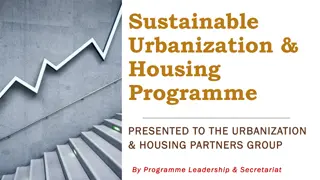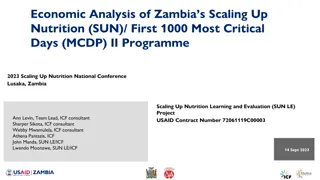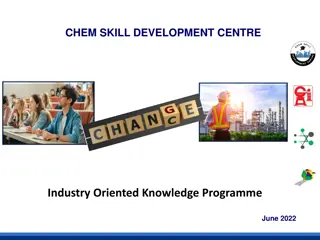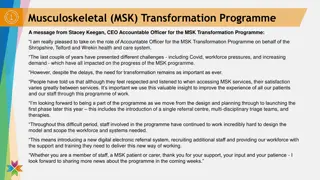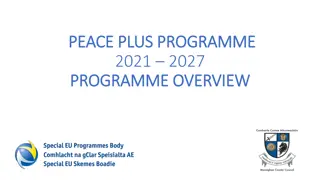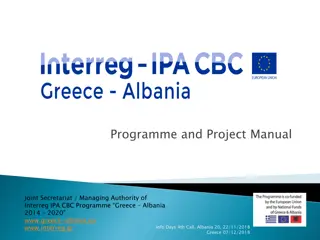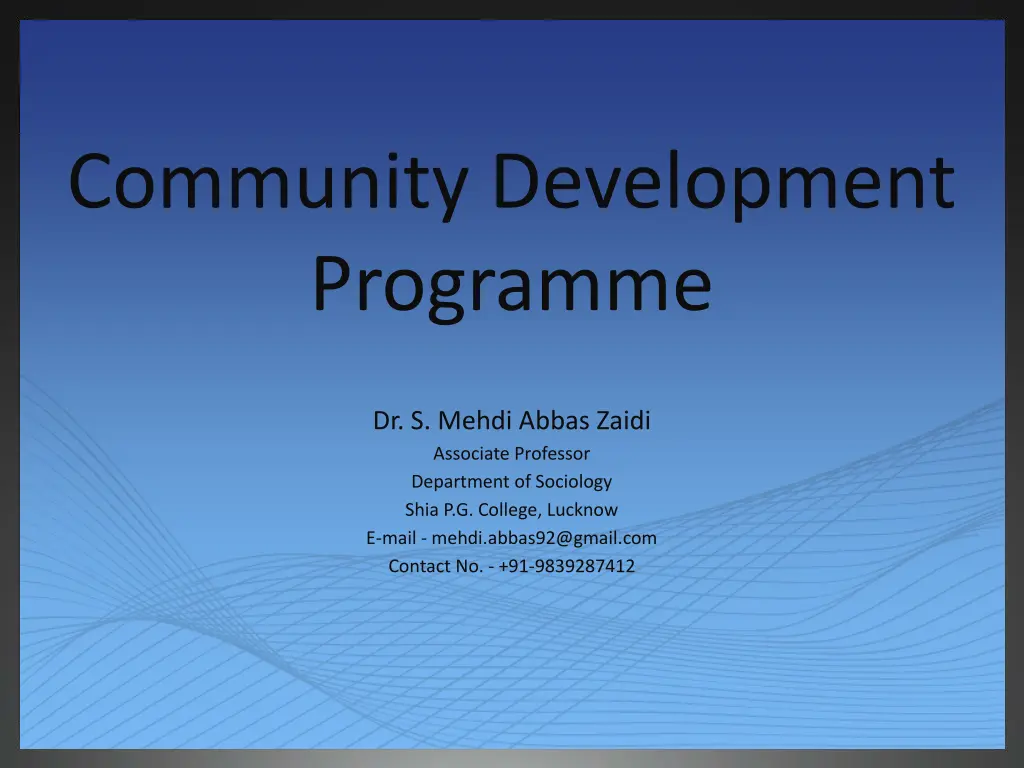
Exploring the Community Development Programme by Dr. S. Mehdi Abbas Zaidi
"Discover the impactful Community Development Programme led by Dr. S. Mehdi Abbas Zaidi from Shia P.G. College, Lucknow. Learn about the objectives, outcomes, and significance of this comprehensive initiative for rural communities in India."
Download Presentation

Please find below an Image/Link to download the presentation.
The content on the website is provided AS IS for your information and personal use only. It may not be sold, licensed, or shared on other websites without obtaining consent from the author. If you encounter any issues during the download, it is possible that the publisher has removed the file from their server.
You are allowed to download the files provided on this website for personal or commercial use, subject to the condition that they are used lawfully. All files are the property of their respective owners.
The content on the website is provided AS IS for your information and personal use only. It may not be sold, licensed, or shared on other websites without obtaining consent from the author.
E N D
Presentation Transcript
Community Development Programme Dr. S. Mehdi Abbas Zaidi Associate Professor Department of Sociology Shia P.G. College, Lucknow E-mail - mehdi.abbas92@gmail.com Contact No. - +91-9839287412
Community Development Programme Community Development Programmes are defined as developmental initiatives, which are aimed at the development of the communities at all levels, including economic, cultural and social. The desired outcomes of these programmes are complex, and may not be known at the outset, but typically include increased self- reliance, and decision making powers resulting from the process of community development.
Continuum It was Nehru s strategic and centralized planning policies, which not only established the community as a site for the privileged agency of the rural poor , but also provided the full backing (including domestic and foreign funding) of the Community Development Programmes (CDP), which were launched in 1952 on the fourth anniversary of Gandhi s death. The Community Development Programme has been the biggest rural reconstruction scheme undertaken by the government of free India.
Continuum It has been variously described as the magnacarta of hope and happiness for two-thirds of India s population, the testament of emancipation, the declaration of war on poverty, ignorance, squalor and disease under which millions have been groaning etc. It is intended to bring both outward and inward grace to the Indian village. The Community Development Programme of the present form is, in the main, an American concept.
Characteristics It promotes self-confidence among the ruralites. It develops self-reliance in the individual and initiative in the village community. The community development programme effects change at the psychological level of the ruralites. It seeks to create new administrative machinery suited to the manifold needs of the village.
Continuum It is pre-eminently people-oriented. Community thinking and collective action are encouraged through people s institutions like the Panchayats, cooperative societies, Vikas mandals, etc.
Importance The programme is instrumental in raising the standard of living of the ruralites and in reconstructing the rural India. Prof. Carl Taylor rightly observes that the programme signifies active cooperation and involvement of the ruralites in formulating and executing their own plans and programmes. The end result is social change, economic development and emergence of new local leadership at the village level.
Aims Prof. S. C. Dube has highlighted on two aims of Community Development Programme. They are: (a) achieving substantial agricultural production and considerable progress in the sphere of communication, rural health and rural education and (b) transforming the socio-economic life of the village through a process of integral cultural change.
Short-term Objectives To increase agricultural production both quantitatively and qualitatively. To solve the problem of rural unemployment. To develop the means of transport and communication in the villages through repairing old roads and constructing new pucka roads.
Continuum To bring about development in the sphere of primary education, public health and recreation. To assist the villagers to build good and cheap houses with the help of modern plans and new building methods. To set up and encourage cottage industries and indigenous handicrafts.
Long-term Objectives The long term objective of community development projects refers to holistic development of rural life through optimum utilisation of physical and human resources. It is further oriented to provide all sorts of facilities available in a Welfare State to the ruralites. Taking care of the social, moral and financial progress of the villagers also comes within the purview of the long-term objectives of community development projects.
Organisation The Community Development Programme is broadly divided into three phases. They are: (a) The National Extension Phase- The areas selected are subjected to the method of providing services on the ordinary rural development pattern with a lesser governmental expenditure. (b) The Intensive Community Development Project Phase- The blocks selected are subjected to more composite and more intensive development schemes with larger governmental expenditure.
Continuum (c) The Post-Intensive Development Phase- It is presumed that the basis for self-perpetuation of the process initiated during the earlier phases has been created and the need for special government expenses reduced. Slowly the areas are left in the charge of the departments for the development. An elaborate organization has been created to implement Community Development Projects; it is known as the Community Project Administration.
Continuum The entire administration is composed of four major types- the central administration, the state administration, the district organization and the project administration. The power and the control flow from top to bottom making it a hierarchic bureaucratic organization.
Scope 1. Agricultural and allied fields: Under this category activities regarding following items are included, (a) reutilisation of virgin and waste lands, (b) repairing of old wells, digging new wells and provision of major/minor irrigation facilities, (c) adoption of qualitative high-yielding seeds, manures, fertilizers, use of tractors etc., (d) provision of credit facilities for the development of animal husbandry, poultry farming, fishery, soil conservation etc. and (e) growth of vegetables and plants etc.
Continuum 2. Organisation: Organisation of co-operative service societies , multi-purpose cooperative societies, marketing co-operatives and other types of people s institutions. 3. Education: Attaching importance to primary education, adult education and social education with the aim of expanding the mental horizon of the ruralites. 4. Employment: For solving the problem of rural unemployment, attempts have been made for the setting up of small scale and cottage industries.
Continuum 5. Health Services: Provision for mobile, permanent dispensaries, arrangements for maternal care, medical aid during pregnancy, midwife service, child care etc. 6. Communication: Repair of old roads, construction of new roads and arrangement for transportation and communication facilities. 7. Vocational training: Imparting vocational training in the field of tailoring, embroidery, carpentry etc.
Continuum 8. Supply of drinking water: Attempting to provide safe drinking water by repairing old wells or constructing new ones. 9. Social welfare: Social welfare activities include rehabilitation of old, disabled and destitute, provision for better housing, organisation of sports, promotion of cultural activities etc.
Suggestions Greater stress is called for increasing agricultural production both quantitatively and qualitatively. Only those officials having expertise in rural psychology should be appointed. Both male and female workers should be selected or appointed from among the villagers themselves. Community development work should be so arranged that cooperation of all castes, classes and parties becomes available.
Continuum Efforts should be made to involve reputed voluntary agencies in Community Development Projects. The development of the village community should come substantially and essentially from the people themselves, the government being only a guide. Balwant Rai Committee has suggested that village Panchayats and Panchayat samitis should function as the veritable instruments for making the programme a success.
Reference Lavanya M.M. & Jain S.K., Rural Sociology Singh V.N. & Singh J., Rural Sociology


